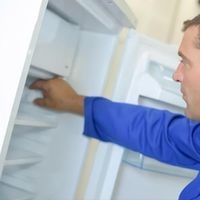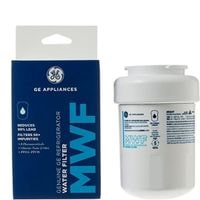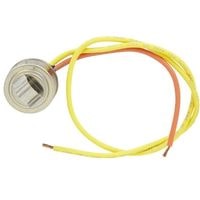GE ice maker not working. Ice makers offer a touch of luxury to any home kitchen. Instead of going through the hassle otherwise required for serving your guest’s ice, just pull a lever, and a handful of cubes should appear into your glass in a matter of seconds.
On their best behavior, that is. Traditionally, ice makers have been very temperamental units, showing off only when they have been recalled from an earlier slumber accompanied by an audible click from its internal mechanism as it gets back to work.
Usually, the only warning you’ll get before an ice maker goes on strike is when you go to open up your dispenser and find nothing but water at its bottom.
If this happens, follow these guidelines to get your ice-making unit working again.
GE ice maker not working
Refrigerators must be kept at a specific temperature. If the temperature is too warm, food will spoil rapidly, especially things like milk, eggs, and cabbage.
Try adjusting the fridge to a slightly colder setting. Your refrigerator is kept on a setting of 37 degrees and your freezer at 0 degrees.
The ice maker will not work above or below the ideal range, so make sure to check both of the set temperatures prior to beginning troubleshooting other possible issues.
And if you’re not getting any ice blocks out of your machine, read on to find out what could be causing your problem and how to fix it.
GE ice maker Too Warm
For the best results, your GE ice maker requires a freezer temperature of 0 degrees F and a fridge temperature of 37 degrees F.
Your GE ice maker has an internal sensor that automatically turns on the ice maker, but may take up to 24 hours at lower temperatures to start making ice.
Be sure your freezer is cold enough below 0 degrees F by adjusting the temperature setting on your ice maker until it gets there at least one day (24hrs) before you plan on using the new ice maker and follow these steps.
Is the Ice Maker On?
A lot of people don’t talk about it, but this one’s pretty common. Many GE refrigerator ice makers have an on/off switch or a mechanical arm that needs to be down for the ice maker to work.
Depending on the model, the on/off switch may be located on the ice maker itself, or you might need to access it by checking your refrigerator’s digital display.
If you have a digital display, check that the ‘ice on’ icon is selected and also check that a child lock feature hasn’t been enabled.
Reset the Ice Maker
Sometimes an issue in the ice maker can be solved by a reset which means turning the power off for a short amount of time.
If it’s not due to a defective part, then you might have to go back and check the connections or reset the breaker. In some cases, you might want to try re-routing the water flow or cleaning out debris that may be causing an issue.
For most models, you should be able to find instructions inside the owner’s manual on how to perform these actions.
The water supply line is connected?
Make sure the refrigerator and ice maker is connected to the water supply line. The water should be turned on. You can find both ends of this line inside your refrigerator. One end is attached to the back of the fridge.
While the other end is attached to the ice maker inside your refrigerator, which produces new ice cubes when needed, additionally, the water filter area can be checked for signs of improper connection.
Check the Water Filter
One of the most common reasons why there isn’t enough ice in your GE refrigerator is that the water filter needs to be changed.
This is not an uncommon problem when you consider that sometimes replacement filters can get misplaced, for example, when someone empties out the old one but doesn’t put the new one incorrectly.
If this happens, then, unfortunately, there’s no way to tell by looking or running a test in your freezer whether or not that’s what happened.
One solution would be to check with all household members to see if they know where it might be hiding out (and if they understand how vital its role really is.
Water Inlet Valve and Water Pressure
The ice maker requires water to have an outlet, which is controlled by the water inlet valve. If this valve is faulty or isn’t getting enough pressure, the ice maker won’t be able to work properly.
The valve can block up if there are minerals present in the water that keep the valve from opening properly. This will cause no water flow into the ice maker and not much juice for you to drink.
You might hear a humming sound coming from your refrigerator when it should be filling up with water – this means there’s a problem with your defective inlet valve; it needs replacing.
Ice Level Control Board
Some GE refrigerators have a function to alert when the ice tray is full. If the ice level in the tray nears its maximum capacity, a signal is activated that communicates with a sensor in the ice maker.
This sensor then generates an electronic pulse that alerts the main control board in the refrigerator. This causes a valve to retract back into its original position and blocks any further ice from being produced.
The control board can lead to a malfunction if it is considered faulty so it would be best for you to check on this component if you notice no ice being made.
Ice Tray Thermostat
If the thermostat is faulty, it won’t let the ice maker know when water or ice is required. You can test whether or not it’s faulty using a multimeter.
If it measures out as defective, then you will need to replace your thermostat.
Ice Maker Switch
To turn on the ice maker switch, flip the lever to the ‘on’ position. However, if it doesn’t seem to function properly and there’s no water flow, check for continuity with a multimeter.
The continuity test will determine whether or not the switch needs to be replaced.
Related Guides
